Analysis of Oil and Gas Industry: Competitive Forces and Strategies
VerifiedAdded on 2021/04/21
|7
|1568
|86
Report
AI Summary
This report provides a comprehensive analysis of the oil and gas industry, focusing on key competitive forces and strategic frameworks. It begins with an examination of Porter's Five Forces, assessing the intensity of competitive rivalry, supplier power, buyer power, the threat of substitutes, and the threat of new entrants within the sector. The report then delves into the application of McKinsey's 7S framework, evaluating the strategic alignment of structure, systems, shared values, style, staff, and skills within oil and gas companies. Finally, the report explores PwC's strategic approaches, including adapting to price changes, leveraging capabilities, forming partnerships, and utilizing technological advancements to enhance performance and profitability. The analysis aims to provide insights into the competitive landscape and strategic considerations for companies operating in the oil and gas industry.
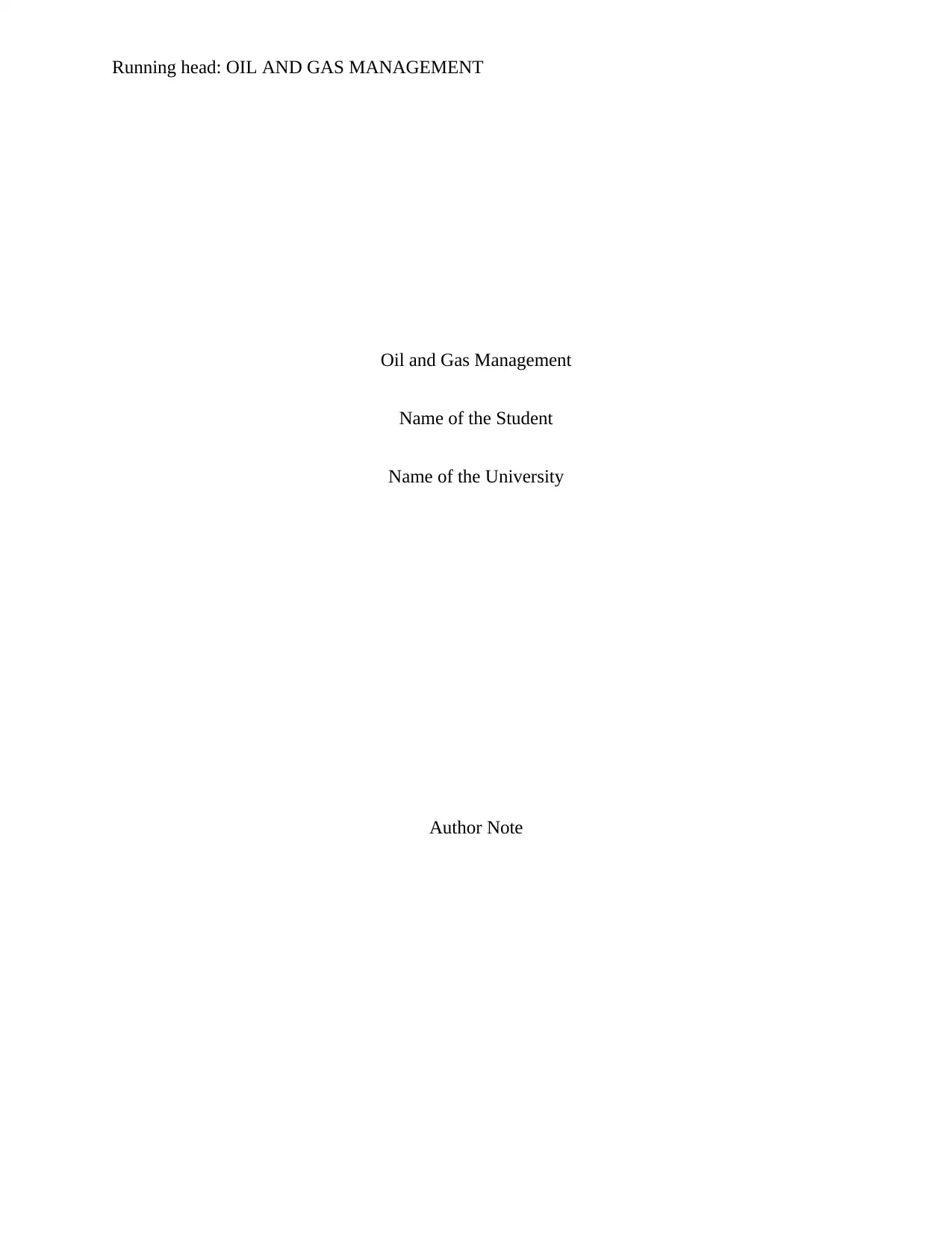
Running head: OIL AND GAS MANAGEMENT
Oil and Gas Management
Name of the Student
Name of the University
Author Note
Oil and Gas Management
Name of the Student
Name of the University
Author Note
Paraphrase This Document
Need a fresh take? Get an instant paraphrase of this document with our AI Paraphraser
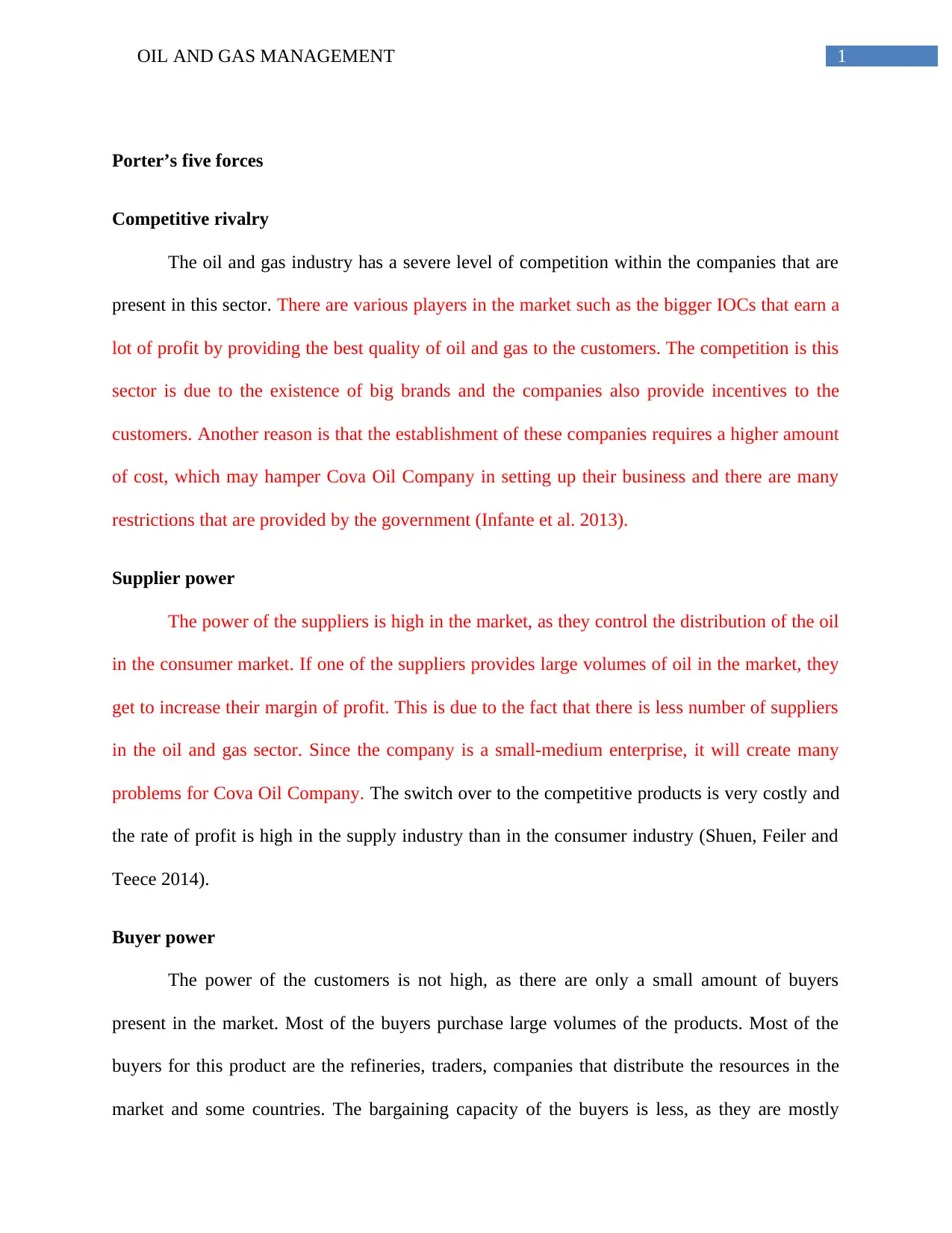
1OIL AND GAS MANAGEMENT
Porter’s five forces
Competitive rivalry
The oil and gas industry has a severe level of competition within the companies that are
present in this sector. There are various players in the market such as the bigger IOCs that earn a
lot of profit by providing the best quality of oil and gas to the customers. The competition is this
sector is due to the existence of big brands and the companies also provide incentives to the
customers. Another reason is that the establishment of these companies requires a higher amount
of cost, which may hamper Cova Oil Company in setting up their business and there are many
restrictions that are provided by the government (Infante et al. 2013).
Supplier power
The power of the suppliers is high in the market, as they control the distribution of the oil
in the consumer market. If one of the suppliers provides large volumes of oil in the market, they
get to increase their margin of profit. This is due to the fact that there is less number of suppliers
in the oil and gas sector. Since the company is a small-medium enterprise, it will create many
problems for Cova Oil Company. The switch over to the competitive products is very costly and
the rate of profit is high in the supply industry than in the consumer industry (Shuen, Feiler and
Teece 2014).
Buyer power
The power of the customers is not high, as there are only a small amount of buyers
present in the market. Most of the buyers purchase large volumes of the products. Most of the
buyers for this product are the refineries, traders, companies that distribute the resources in the
market and some countries. The bargaining capacity of the buyers is less, as they are mostly
Porter’s five forces
Competitive rivalry
The oil and gas industry has a severe level of competition within the companies that are
present in this sector. There are various players in the market such as the bigger IOCs that earn a
lot of profit by providing the best quality of oil and gas to the customers. The competition is this
sector is due to the existence of big brands and the companies also provide incentives to the
customers. Another reason is that the establishment of these companies requires a higher amount
of cost, which may hamper Cova Oil Company in setting up their business and there are many
restrictions that are provided by the government (Infante et al. 2013).
Supplier power
The power of the suppliers is high in the market, as they control the distribution of the oil
in the consumer market. If one of the suppliers provides large volumes of oil in the market, they
get to increase their margin of profit. This is due to the fact that there is less number of suppliers
in the oil and gas sector. Since the company is a small-medium enterprise, it will create many
problems for Cova Oil Company. The switch over to the competitive products is very costly and
the rate of profit is high in the supply industry than in the consumer industry (Shuen, Feiler and
Teece 2014).
Buyer power
The power of the customers is not high, as there are only a small amount of buyers
present in the market. Most of the buyers purchase large volumes of the products. Most of the
buyers for this product are the refineries, traders, companies that distribute the resources in the
market and some countries. The bargaining capacity of the buyers is less, as they are mostly
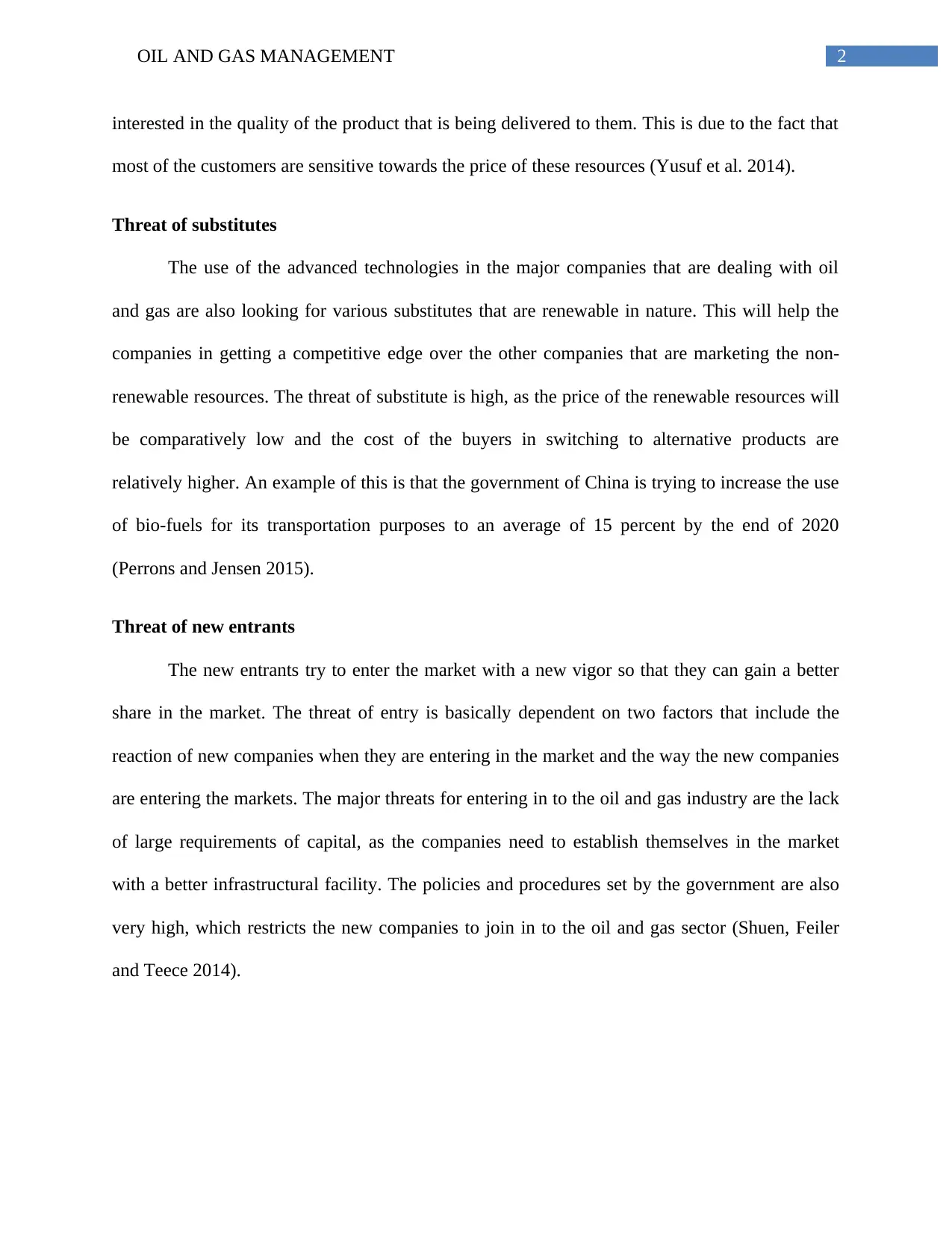
2OIL AND GAS MANAGEMENT
interested in the quality of the product that is being delivered to them. This is due to the fact that
most of the customers are sensitive towards the price of these resources (Yusuf et al. 2014).
Threat of substitutes
The use of the advanced technologies in the major companies that are dealing with oil
and gas are also looking for various substitutes that are renewable in nature. This will help the
companies in getting a competitive edge over the other companies that are marketing the non-
renewable resources. The threat of substitute is high, as the price of the renewable resources will
be comparatively low and the cost of the buyers in switching to alternative products are
relatively higher. An example of this is that the government of China is trying to increase the use
of bio-fuels for its transportation purposes to an average of 15 percent by the end of 2020
(Perrons and Jensen 2015).
Threat of new entrants
The new entrants try to enter the market with a new vigor so that they can gain a better
share in the market. The threat of entry is basically dependent on two factors that include the
reaction of new companies when they are entering in the market and the way the new companies
are entering the markets. The major threats for entering in to the oil and gas industry are the lack
of large requirements of capital, as the companies need to establish themselves in the market
with a better infrastructural facility. The policies and procedures set by the government are also
very high, which restricts the new companies to join in to the oil and gas sector (Shuen, Feiler
and Teece 2014).
interested in the quality of the product that is being delivered to them. This is due to the fact that
most of the customers are sensitive towards the price of these resources (Yusuf et al. 2014).
Threat of substitutes
The use of the advanced technologies in the major companies that are dealing with oil
and gas are also looking for various substitutes that are renewable in nature. This will help the
companies in getting a competitive edge over the other companies that are marketing the non-
renewable resources. The threat of substitute is high, as the price of the renewable resources will
be comparatively low and the cost of the buyers in switching to alternative products are
relatively higher. An example of this is that the government of China is trying to increase the use
of bio-fuels for its transportation purposes to an average of 15 percent by the end of 2020
(Perrons and Jensen 2015).
Threat of new entrants
The new entrants try to enter the market with a new vigor so that they can gain a better
share in the market. The threat of entry is basically dependent on two factors that include the
reaction of new companies when they are entering in the market and the way the new companies
are entering the markets. The major threats for entering in to the oil and gas industry are the lack
of large requirements of capital, as the companies need to establish themselves in the market
with a better infrastructural facility. The policies and procedures set by the government are also
very high, which restricts the new companies to join in to the oil and gas sector (Shuen, Feiler
and Teece 2014).
⊘ This is a preview!⊘
Do you want full access?
Subscribe today to unlock all pages.

Trusted by 1+ million students worldwide
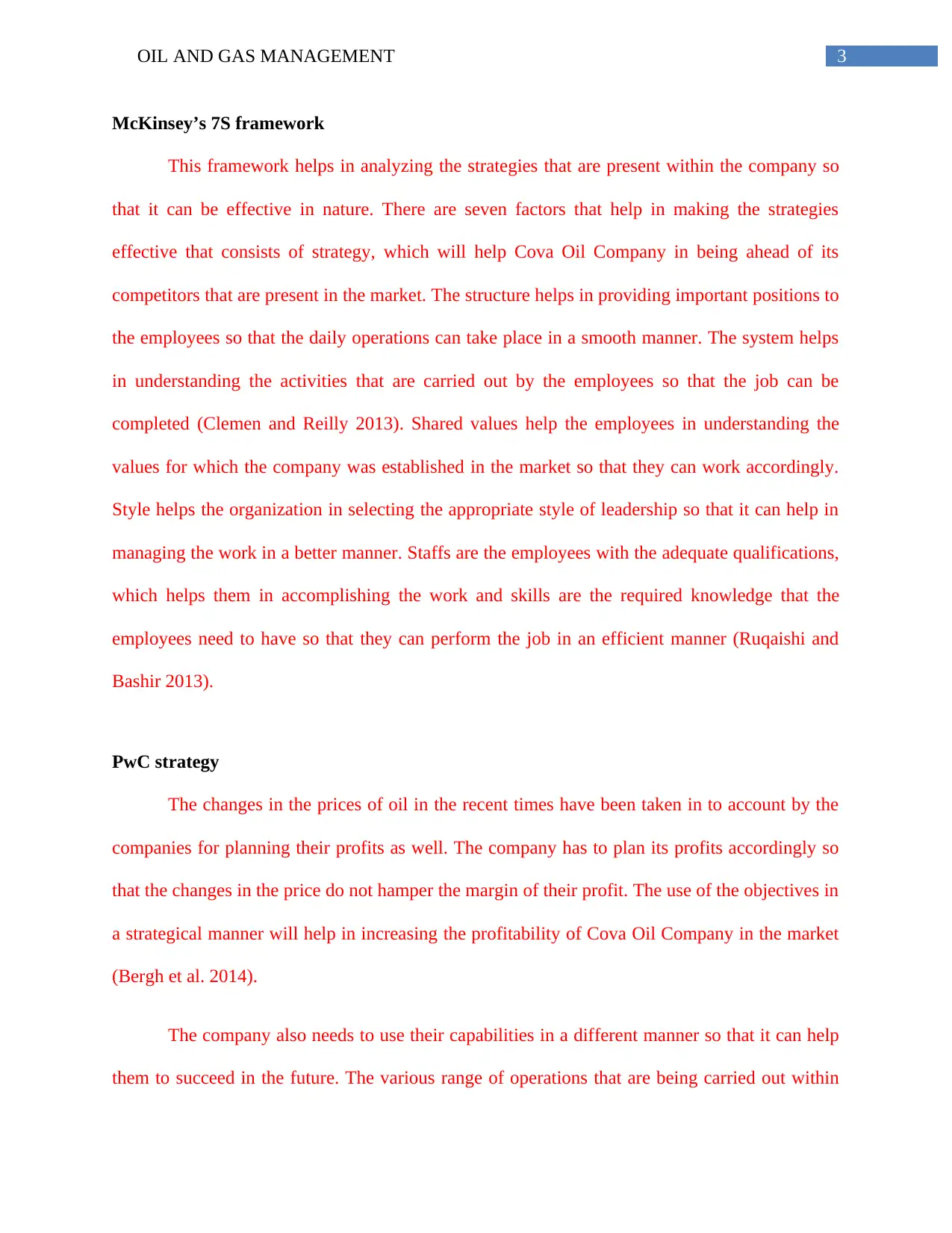
3OIL AND GAS MANAGEMENT
McKinsey’s 7S framework
This framework helps in analyzing the strategies that are present within the company so
that it can be effective in nature. There are seven factors that help in making the strategies
effective that consists of strategy, which will help Cova Oil Company in being ahead of its
competitors that are present in the market. The structure helps in providing important positions to
the employees so that the daily operations can take place in a smooth manner. The system helps
in understanding the activities that are carried out by the employees so that the job can be
completed (Clemen and Reilly 2013). Shared values help the employees in understanding the
values for which the company was established in the market so that they can work accordingly.
Style helps the organization in selecting the appropriate style of leadership so that it can help in
managing the work in a better manner. Staffs are the employees with the adequate qualifications,
which helps them in accomplishing the work and skills are the required knowledge that the
employees need to have so that they can perform the job in an efficient manner (Ruqaishi and
Bashir 2013).
PwC strategy
The changes in the prices of oil in the recent times have been taken in to account by the
companies for planning their profits as well. The company has to plan its profits accordingly so
that the changes in the price do not hamper the margin of their profit. The use of the objectives in
a strategical manner will help in increasing the profitability of Cova Oil Company in the market
(Bergh et al. 2014).
The company also needs to use their capabilities in a different manner so that it can help
them to succeed in the future. The various range of operations that are being carried out within
McKinsey’s 7S framework
This framework helps in analyzing the strategies that are present within the company so
that it can be effective in nature. There are seven factors that help in making the strategies
effective that consists of strategy, which will help Cova Oil Company in being ahead of its
competitors that are present in the market. The structure helps in providing important positions to
the employees so that the daily operations can take place in a smooth manner. The system helps
in understanding the activities that are carried out by the employees so that the job can be
completed (Clemen and Reilly 2013). Shared values help the employees in understanding the
values for which the company was established in the market so that they can work accordingly.
Style helps the organization in selecting the appropriate style of leadership so that it can help in
managing the work in a better manner. Staffs are the employees with the adequate qualifications,
which helps them in accomplishing the work and skills are the required knowledge that the
employees need to have so that they can perform the job in an efficient manner (Ruqaishi and
Bashir 2013).
PwC strategy
The changes in the prices of oil in the recent times have been taken in to account by the
companies for planning their profits as well. The company has to plan its profits accordingly so
that the changes in the price do not hamper the margin of their profit. The use of the objectives in
a strategical manner will help in increasing the profitability of Cova Oil Company in the market
(Bergh et al. 2014).
The company also needs to use their capabilities in a different manner so that it can help
them to succeed in the future. The various range of operations that are being carried out within
Paraphrase This Document
Need a fresh take? Get an instant paraphrase of this document with our AI Paraphraser
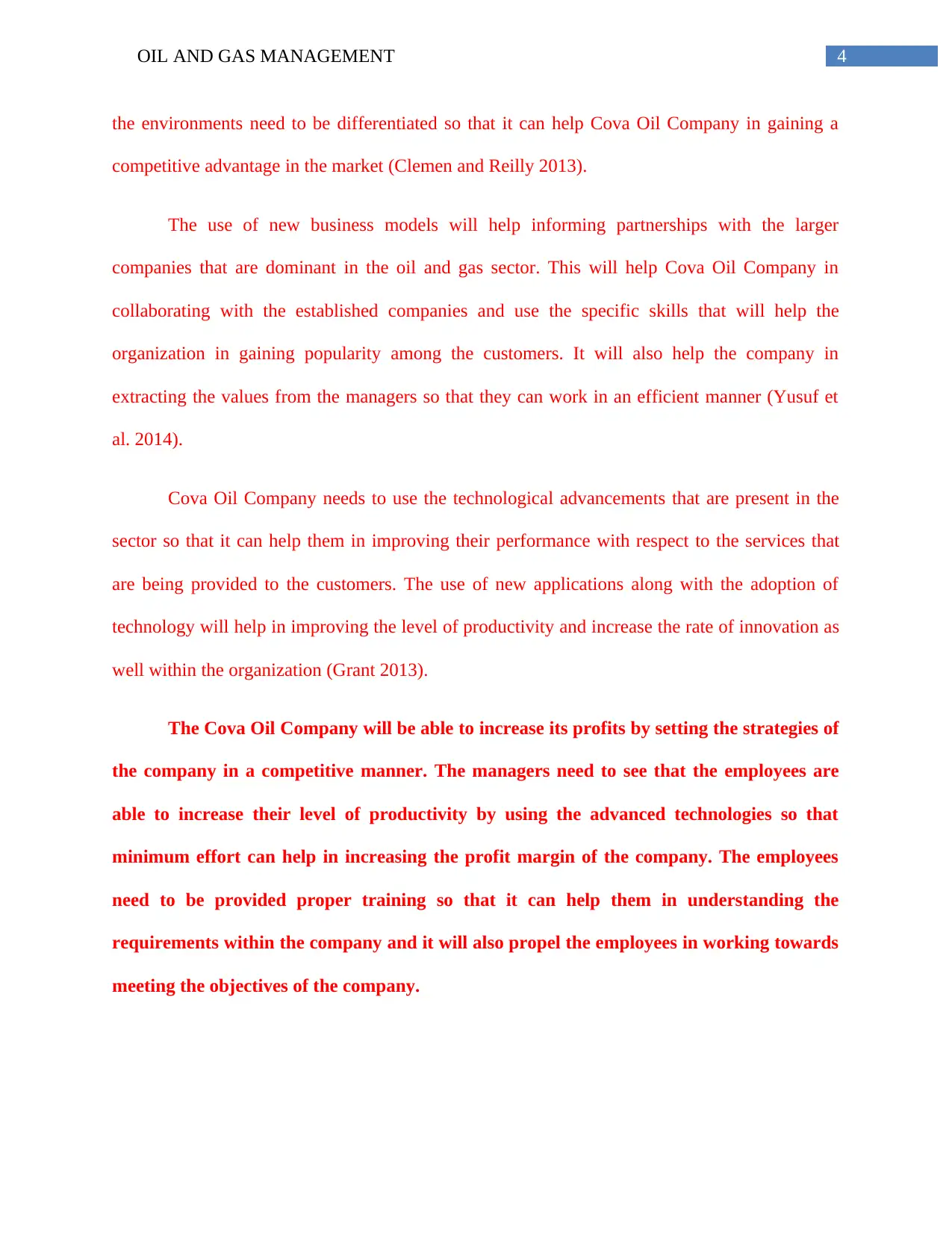
4OIL AND GAS MANAGEMENT
the environments need to be differentiated so that it can help Cova Oil Company in gaining a
competitive advantage in the market (Clemen and Reilly 2013).
The use of new business models will help informing partnerships with the larger
companies that are dominant in the oil and gas sector. This will help Cova Oil Company in
collaborating with the established companies and use the specific skills that will help the
organization in gaining popularity among the customers. It will also help the company in
extracting the values from the managers so that they can work in an efficient manner (Yusuf et
al. 2014).
Cova Oil Company needs to use the technological advancements that are present in the
sector so that it can help them in improving their performance with respect to the services that
are being provided to the customers. The use of new applications along with the adoption of
technology will help in improving the level of productivity and increase the rate of innovation as
well within the organization (Grant 2013).
The Cova Oil Company will be able to increase its profits by setting the strategies of
the company in a competitive manner. The managers need to see that the employees are
able to increase their level of productivity by using the advanced technologies so that
minimum effort can help in increasing the profit margin of the company. The employees
need to be provided proper training so that it can help them in understanding the
requirements within the company and it will also propel the employees in working towards
meeting the objectives of the company.
the environments need to be differentiated so that it can help Cova Oil Company in gaining a
competitive advantage in the market (Clemen and Reilly 2013).
The use of new business models will help informing partnerships with the larger
companies that are dominant in the oil and gas sector. This will help Cova Oil Company in
collaborating with the established companies and use the specific skills that will help the
organization in gaining popularity among the customers. It will also help the company in
extracting the values from the managers so that they can work in an efficient manner (Yusuf et
al. 2014).
Cova Oil Company needs to use the technological advancements that are present in the
sector so that it can help them in improving their performance with respect to the services that
are being provided to the customers. The use of new applications along with the adoption of
technology will help in improving the level of productivity and increase the rate of innovation as
well within the organization (Grant 2013).
The Cova Oil Company will be able to increase its profits by setting the strategies of
the company in a competitive manner. The managers need to see that the employees are
able to increase their level of productivity by using the advanced technologies so that
minimum effort can help in increasing the profit margin of the company. The employees
need to be provided proper training so that it can help them in understanding the
requirements within the company and it will also propel the employees in working towards
meeting the objectives of the company.
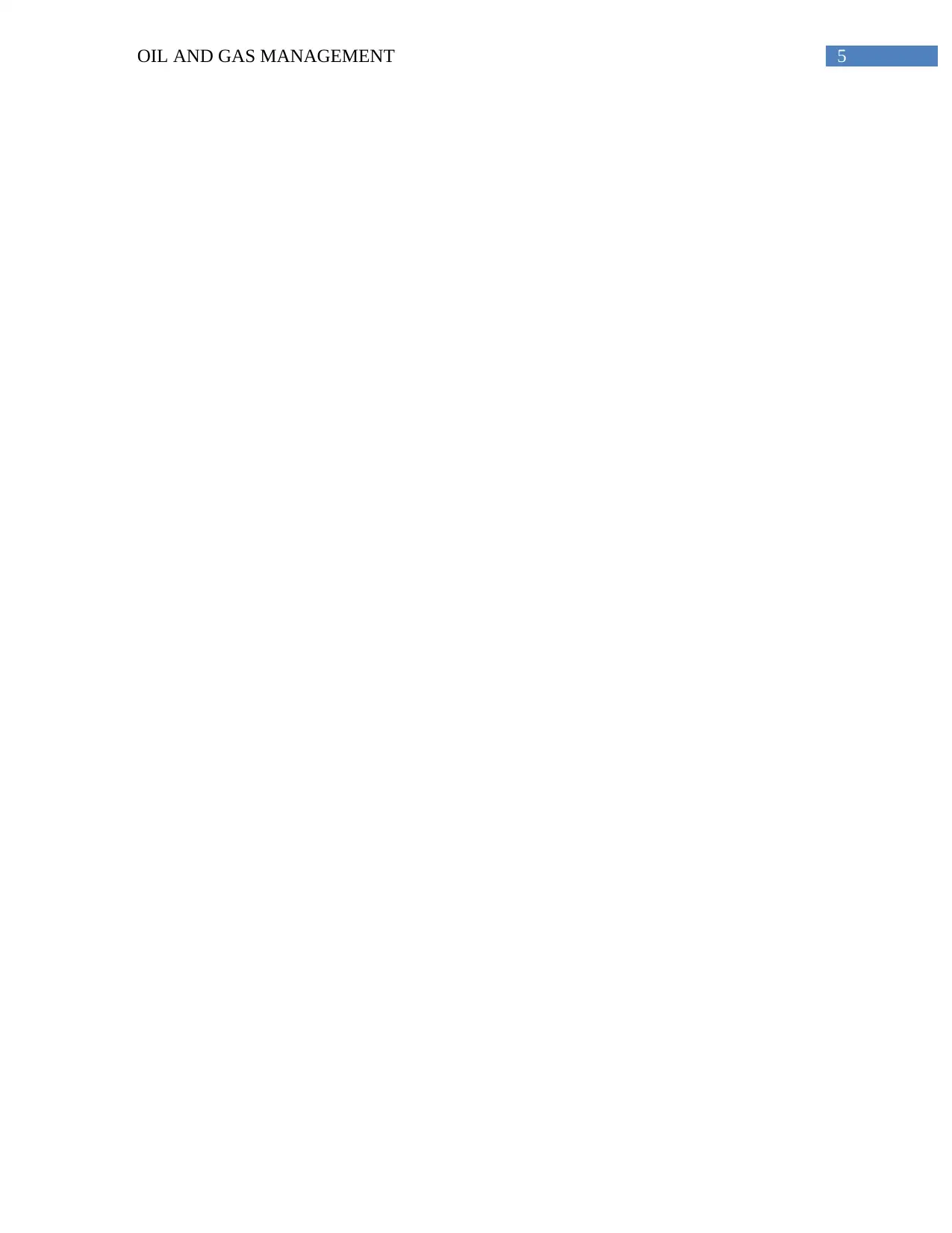
5OIL AND GAS MANAGEMENT
⊘ This is a preview!⊘
Do you want full access?
Subscribe today to unlock all pages.

Trusted by 1+ million students worldwide
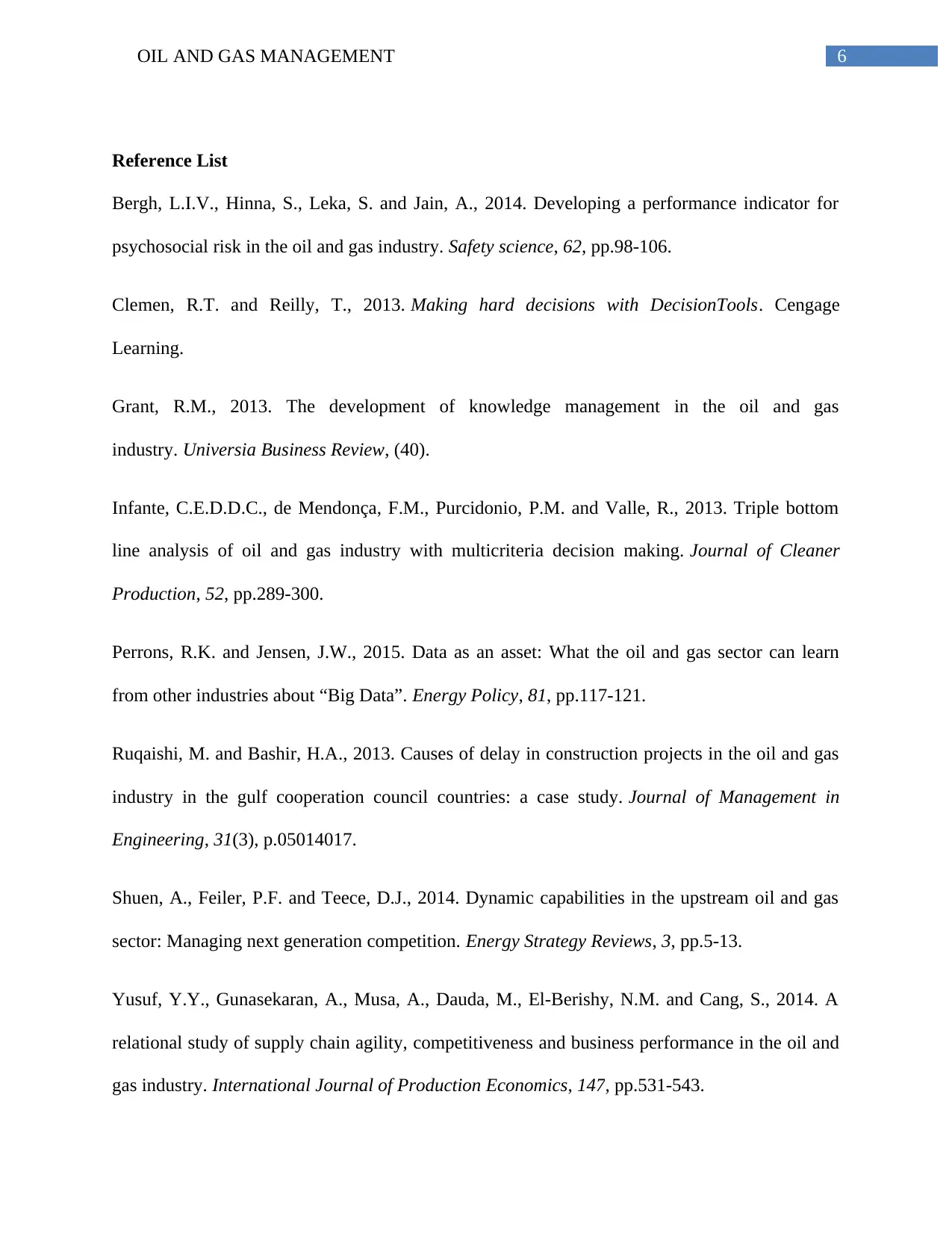
6OIL AND GAS MANAGEMENT
Reference List
Bergh, L.I.V., Hinna, S., Leka, S. and Jain, A., 2014. Developing a performance indicator for
psychosocial risk in the oil and gas industry. Safety science, 62, pp.98-106.
Clemen, R.T. and Reilly, T., 2013. Making hard decisions with DecisionTools. Cengage
Learning.
Grant, R.M., 2013. The development of knowledge management in the oil and gas
industry. Universia Business Review, (40).
Infante, C.E.D.D.C., de Mendonça, F.M., Purcidonio, P.M. and Valle, R., 2013. Triple bottom
line analysis of oil and gas industry with multicriteria decision making. Journal of Cleaner
Production, 52, pp.289-300.
Perrons, R.K. and Jensen, J.W., 2015. Data as an asset: What the oil and gas sector can learn
from other industries about “Big Data”. Energy Policy, 81, pp.117-121.
Ruqaishi, M. and Bashir, H.A., 2013. Causes of delay in construction projects in the oil and gas
industry in the gulf cooperation council countries: a case study. Journal of Management in
Engineering, 31(3), p.05014017.
Shuen, A., Feiler, P.F. and Teece, D.J., 2014. Dynamic capabilities in the upstream oil and gas
sector: Managing next generation competition. Energy Strategy Reviews, 3, pp.5-13.
Yusuf, Y.Y., Gunasekaran, A., Musa, A., Dauda, M., El-Berishy, N.M. and Cang, S., 2014. A
relational study of supply chain agility, competitiveness and business performance in the oil and
gas industry. International Journal of Production Economics, 147, pp.531-543.
Reference List
Bergh, L.I.V., Hinna, S., Leka, S. and Jain, A., 2014. Developing a performance indicator for
psychosocial risk in the oil and gas industry. Safety science, 62, pp.98-106.
Clemen, R.T. and Reilly, T., 2013. Making hard decisions with DecisionTools. Cengage
Learning.
Grant, R.M., 2013. The development of knowledge management in the oil and gas
industry. Universia Business Review, (40).
Infante, C.E.D.D.C., de Mendonça, F.M., Purcidonio, P.M. and Valle, R., 2013. Triple bottom
line analysis of oil and gas industry with multicriteria decision making. Journal of Cleaner
Production, 52, pp.289-300.
Perrons, R.K. and Jensen, J.W., 2015. Data as an asset: What the oil and gas sector can learn
from other industries about “Big Data”. Energy Policy, 81, pp.117-121.
Ruqaishi, M. and Bashir, H.A., 2013. Causes of delay in construction projects in the oil and gas
industry in the gulf cooperation council countries: a case study. Journal of Management in
Engineering, 31(3), p.05014017.
Shuen, A., Feiler, P.F. and Teece, D.J., 2014. Dynamic capabilities in the upstream oil and gas
sector: Managing next generation competition. Energy Strategy Reviews, 3, pp.5-13.
Yusuf, Y.Y., Gunasekaran, A., Musa, A., Dauda, M., El-Berishy, N.M. and Cang, S., 2014. A
relational study of supply chain agility, competitiveness and business performance in the oil and
gas industry. International Journal of Production Economics, 147, pp.531-543.
1 out of 7
Related Documents
Your All-in-One AI-Powered Toolkit for Academic Success.
+13062052269
info@desklib.com
Available 24*7 on WhatsApp / Email
![[object Object]](/_next/static/media/star-bottom.7253800d.svg)
Unlock your academic potential
Copyright © 2020–2025 A2Z Services. All Rights Reserved. Developed and managed by ZUCOL.



